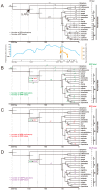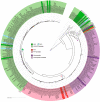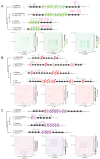Expansion and Diversification of Fluorescent Protein Genes in Fifteen Acropora Species during the Evolution of Acroporid Corals
- PMID: 33799612
- PMCID: PMC8001845
- DOI: 10.3390/genes12030397
Expansion and Diversification of Fluorescent Protein Genes in Fifteen Acropora Species during the Evolution of Acroporid Corals
Abstract
In addition to a purple, non-fluorescent chromoprotein (ChrP), fluorescent proteins (FPs) account for the vivid colors of corals, which occur in green (GFP), cyan (CFP), and red (RFP) FPs. To understand the evolution of the coral FP gene family, we examined the genomes of 15 Acropora species and three confamilial taxa. This genome-wide survey identified 219 FP genes. Molecular phylogeny revealed that the 15 Acropora species each have 9-18 FP genes, whereas the other acroporids examined have only two, suggesting a pronounced expansion of the FP genes in the genus Acropora. The data estimates of FP gene duplication suggest that the last common ancestor of the Acropora species that survived in the period of high sea surface temperature (Paleogene period) has already gained 16 FP genes. Different evolutionary histories of lineage-specific duplication and loss were discovered among GFP/CFPs, RFPs, and ChrPs. Synteny analysis revealed core GFP/CFP, RFP, and ChrP gene clusters, in which a tandem duplication of the FP genes was evident. The expansion and diversification of Acropora FPs may have contributed to the present-day richness of this genus.
Keywords: Acropora; Acroporidae; chromoprotein; corals; fluorescent proteins; gene expansion; tandem duplication.
Conflict of interest statement
The authors declare no conflict of interest.
Figures




Similar articles
-
Fluorescent protein candidate genes in the coral Acropora digitifera genome.Zoolog Sci. 2012 Apr;29(4):260-4. doi: 10.2108/zsj.29.260. Zoolog Sci. 2012. PMID: 22468836
-
Acropora digitifera Encodes the Largest Known Family of Fluorescent Proteins that Has Persisted during the Evolution of Acropora Species.Genome Biol Evol. 2016 Dec 5;8(11):3271-3283. doi: 10.1093/gbe/evw265. Genome Biol Evol. 2016. PMID: 27920057 Free PMC article.
-
Diversity and evolution of coral fluorescent proteins.PLoS One. 2008 Jul 16;3(7):e2680. doi: 10.1371/journal.pone.0002680. PLoS One. 2008. PMID: 18648549 Free PMC article.
-
The molecular properties and applications of Anthozoa fluorescent proteins and chromoproteins.Nat Biotechnol. 2004 Mar;22(3):289-96. doi: 10.1038/nbt943. Nat Biotechnol. 2004. PMID: 14990950 Review.
-
A short guide on blue fluorescent proteins: limits and perspectives.Appl Microbiol Biotechnol. 2024 Feb 14;108(1):208. doi: 10.1007/s00253-024-13012-w. Appl Microbiol Biotechnol. 2024. PMID: 38353763 Free PMC article. Review.
Cited by
-
Coexistence of nonfluorescent chromoproteins and fluorescent proteins in massive Porites spp. corals manifesting a pink pigmentation response.Front Physiol. 2024 Jun 17;15:1339907. doi: 10.3389/fphys.2024.1339907. eCollection 2024. Front Physiol. 2024. PMID: 38952870 Free PMC article.
-
Developmental system drift and modular gene regulatory networks shape gastrulation in Acropora.Life Sci Alliance. 2025 Aug 14;8(11):e202503293. doi: 10.26508/lsa.202503293. Print 2025 Nov. Life Sci Alliance. 2025. PMID: 40813231 Free PMC article.
-
Gene clusters for biosynthesis of mycosporine-like amino acids in dinoflagellate nuclear genomes: Possible recent horizontal gene transfer between species of Symbiodiniaceae (Dinophyceae).J Phycol. 2022 Feb;58(1):1-11. doi: 10.1111/jpy.13219. Epub 2021 Nov 26. J Phycol. 2022. PMID: 34699617 Free PMC article. Review.
-
The Evolution of Invertebrate Animals.Genes (Basel). 2022 Mar 2;13(3):454. doi: 10.3390/genes13030454. Genes (Basel). 2022. PMID: 35328008 Free PMC article.
References
-
- Dove S.G., Hoegh-Guldberg O., Ranganathan S. Major colour patterns of reef-building corals are due to a family of GFP-like proteins. Coral Reefs. 2001;19:197–204. doi: 10.1007/PL00006956. - DOI
-
- Mazel C.H., Lesser M.P., Gorbunov M.Y., Barry T.M., Farrell J.H., Wyman K.D., Falkowski P.G. Green-fluorescent proteins in Caribbean corals. Limnol. Oceanogr. 2003;48:402–411. doi: 10.4319/lo.2003.48.1_part_2.0402. - DOI
Publication types
MeSH terms
Substances
LinkOut - more resources
Full Text Sources
Other Literature Sources
Miscellaneous

